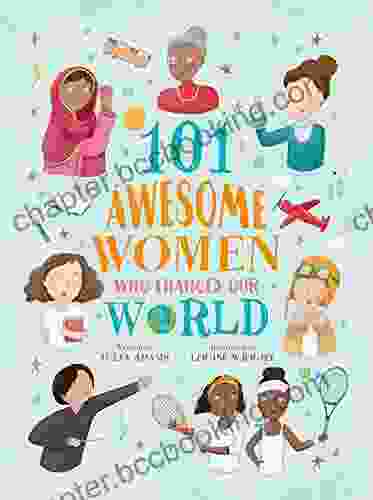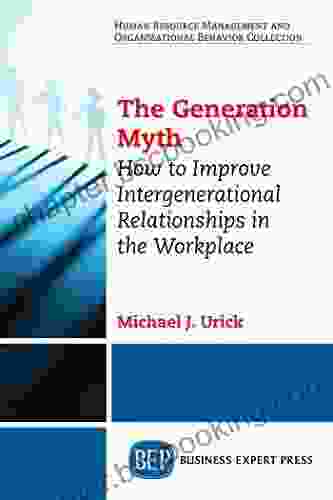How to Improve Intergenerational Relationships in the Workplace: A Comprehensive Guide

In today's rapidly evolving business landscape, where multiple generations converge within the workplace, fostering harmonious intergenerational relationships is paramount to organizational success. This comprehensive guide will delve into the intricacies of intergenerational dynamics, empowering workplaces to effectively navigate the challenges and harness the opportunities associated with generational diversity.
5 out of 5
| Language | : | English |
| File size | : | 1008 KB |
| Text-to-Speech | : | Enabled |
| Screen Reader | : | Supported |
| Enhanced typesetting | : | Enabled |
| Word Wise | : | Enabled |
| Print length | : | 144 pages |
Understanding Generational Differences
The workplace comprises individuals of varying ages, backgrounds, and experiences, representing distinct generations. Understanding the unique characteristics, values, and communication styles of each generation is crucial for building bridges and establishing a cohesive work environment.
- Traditionalists (born before 1946): Value hierarchy, respect for authority, and stability. Prefer structured environments and face-to-face communication.
- Baby Boomers (born 1946-1964): Ambitious, competitive, and team-oriented. Seek opportunities for career advancement and value personal fulfillment.
- Generation X (born 1965-1980): Independent, adaptable, and tech-savvy. Prioritize work-life balance and value flexibility.
- Millennials (born 1981-1996): Digitally native, collaborative, and purpose-driven. Value social impact, diversity, and meaningful work.
- Generation Z (born 1997-2012): Entrepreneurial, tech-fluent, and socially conscious. Seek authentic connections and value authenticity in the workplace.
Bridging Generational Gaps
While generational differences may present challenges, they also offer valuable opportunities for growth and innovation. By embracing a proactive approach and implementing targeted strategies, organizations can effectively bridge generational gaps and foster a positive and inclusive work environment.
- Create a Culture of Respect: Encourage open dialogue, active listening, and empathy across generations. Promote a workplace where all voices are valued and respected.
- Foster Intergenerational Mentoring: Establish structured programs that pair individuals from different generations for mentorship and knowledge exchange. This promotes cross-generational understanding and supports professional development.
- Encourage Cross-Generational Collaboration: Engage teams in projects that bring together individuals from diverse generations. Leverage their collective experiences and perspectives to spark innovation and drive success.
- Implement Flexible Work Arrangements: Offer flexible work schedules, remote work options, and part-time employment to accommodate the needs of employees from different generations and life stages.
- Promote Intergenerational Social Activities: Organize company events, social gatherings, and team-building activities that encourage intergenerational interaction and foster a sense of community.
Effective Communication
Clear and effective communication is fundamental to bridging generational gaps. Adapting communication styles to align with the preferences of different generations is essential for fostering understanding and avoiding misunderstandings.
- Tailor Communication Channels: Use a combination of communication channels (e.g., email, instant messaging, video conferencing) to cater to the preferences of different generations.
- Clarify Expectations: Clearly define roles, responsibilities, and communication protocols to avoid generational confusion or misinterpretations.
- Provide Feedback Regularly: Offer regular feedback to employees of all generations, focusing on strengths, areas for improvement, and professional development opportunities.
- Avoid Generational Stereotypes: Refrain from making assumptions or generalizations based on age or generational affiliation. Treat each employee as an individual with unique strengths and needs.
Understanding Generational Perspectives
To effectively bridge generational gaps, it is important to recognize and understand the unique perspectives of each generation. By valuing their distinct contributions, organizations can create a workplace where all employees feel empowered and engaged.
- Traditionalists: Value experience, expertise, and loyalty. Seek stability, structure, and clear career paths.
- Baby Boomers: Value teamwork, collaboration, and work-life balance. Seek opportunities for professional growth and meaningful challenges.
- Generation X: Value independence, adaptability, and flexibility. Seek work-life balance, job security, and opportunities for personal growth.
- Millennials: Value purpose, social impact, and diversity. Seek opportunities to make a difference, collaborate with others, and develop their skills.
- Generation Z: Value authenticity, transparency, and social consciousness. Seek meaningful work, flexible arrangements, and opportunities to contribute to societal change.
Generational Collaboration: A Catalyst for Innovation
Fostering intergenerational collaboration is not merely about bridging gaps; it is about harnessing the collective wisdom, experiences, and perspectives of diverse generations to drive innovation and organizational success.
- Cross-Generational Project Teams: Form project teams that bring together individuals from different generations to leverage their combined knowledge and skills.
- Reverse Mentoring: Encourage younger employees to mentor senior leaders, sharing their expertise in technology, social media, and emerging trends.
- Intergenerational Knowledge Sharing: Establish platforms for employees to share their experiences, insights, and best practices across generations.
- Generational Inclusion Committees: Create committees that represent different generations to provide input on workplace policies, programs, and initiatives.
Fostering harmonious intergenerational relationships in the workplace is a multifaceted endeavor that requires a proactive, empathetic, and inclusive approach. By embracing generational diversity, understanding generational perspectives, and implementing targeted strategies, organizations can create a workplace where individuals from all generations feel valued, respected, and empowered. This inclusive and collaborative environment will ultimately drive innovation, enhance productivity, and foster organizational success.
Call to Action
Take the first step toward improving intergenerational relationships in your workplace by Free Downloading your copy of "How to Improve Intergenerational Relationships in the Workplace" today. This comprehensive guide provides valuable insights, strategies, and case studies to help you build a more cohesive, productive, and innovative work environment.
### **Image alt attributes:**
* **Traditionalists image:** Elderly workers collaborating in a traditional office setting * **Baby Boomers image:** A group of baby boomers working together in a modern coworking space * **Generation X image:** A team of Gen Xers working on a project using laptops and tablets * **Millennials image:** A diverse group of millennials brainstorming ideas in a creative and collaborative environment * **Generation Z image:** A young employee presenting a proposal using a virtual reality headset, surrounded by a team of colleagues from different generations
5 out of 5
| Language | : | English |
| File size | : | 1008 KB |
| Text-to-Speech | : | Enabled |
| Screen Reader | : | Supported |
| Enhanced typesetting | : | Enabled |
| Word Wise | : | Enabled |
| Print length | : | 144 pages |
Do you want to contribute by writing guest posts on this blog?
Please contact us and send us a resume of previous articles that you have written.
 Book
Book Novel
Novel Page
Page Chapter
Chapter Text
Text Story
Story Genre
Genre Reader
Reader Library
Library Paperback
Paperback E-book
E-book Magazine
Magazine Newspaper
Newspaper Paragraph
Paragraph Sentence
Sentence Bookmark
Bookmark Shelf
Shelf Glossary
Glossary Bibliography
Bibliography Foreword
Foreword Preface
Preface Synopsis
Synopsis Annotation
Annotation Footnote
Footnote Manuscript
Manuscript Scroll
Scroll Codex
Codex Tome
Tome Bestseller
Bestseller Classics
Classics Library card
Library card Narrative
Narrative Biography
Biography Autobiography
Autobiography Memoir
Memoir Reference
Reference Encyclopedia
Encyclopedia Natsume Soseki
Natsume Soseki Michael Kusugak
Michael Kusugak Mike Dean
Mike Dean Prabhu Tl
Prabhu Tl Sarah Sills
Sarah Sills Rob Marley
Rob Marley Ross Bonander
Ross Bonander Xueting Christine Ni
Xueting Christine Ni W N P Barbellion
W N P Barbellion Rose Rivera
Rose Rivera Thane K Pratt
Thane K Pratt William C Taylor
William C Taylor Julia A Ericksen
Julia A Ericksen Varg Freeborn
Varg Freeborn Thomas Kurz
Thomas Kurz Semion Vinokur
Semion Vinokur Stacey Lee
Stacey Lee Nathaniel Rich
Nathaniel Rich Saunders Mac Lane
Saunders Mac Lane Nick Heil
Nick Heil
Light bulbAdvertise smarter! Our strategic ad space ensures maximum exposure. Reserve your spot today!

 Bernard PowellGrade Gcse Physical Education Ocr Complete Revision Practice: Your Ultimate...
Bernard PowellGrade Gcse Physical Education Ocr Complete Revision Practice: Your Ultimate...
 Geoffrey BlairRegents Physics Physical Setting Power Pack Revised Edition: Enhance Your...
Geoffrey BlairRegents Physics Physical Setting Power Pack Revised Edition: Enhance Your... Aron CoxFollow ·8.8k
Aron CoxFollow ·8.8k Greg FosterFollow ·18.9k
Greg FosterFollow ·18.9k Gordon CoxFollow ·18.8k
Gordon CoxFollow ·18.8k Evan HayesFollow ·15.2k
Evan HayesFollow ·15.2k Jacques BellFollow ·9.7k
Jacques BellFollow ·9.7k Edgar HayesFollow ·16.5k
Edgar HayesFollow ·16.5k Colt SimmonsFollow ·10.8k
Colt SimmonsFollow ·10.8k Pete BlairFollow ·19.5k
Pete BlairFollow ·19.5k

 Trevor Bell
Trevor BellUncover the Thrilling Mystery in "It Ain't Over, Cole...
Prepare yourself...

 Garrett Bell
Garrett BellHow to Stay True to Yourself and Stand Out From the Crowd
In a world that...

 Dennis Hayes
Dennis HayesDrill Instructor Strategies And Tactics For Success
Unleash Your Inner Warrior and Conquer...

 Guy Powell
Guy Powell101 Awesome Women Who Changed Our World: A Celebration of...
Throughout history,...

 Ashton Reed
Ashton ReedAn Iraq War Tank Commander's Inspirational Memoir of...
When he was just 19 years old, John Q....

 Dean Cox
Dean CoxLady Trader in the Transvaal: A Literary Safari through a...
Prologue: A Journey into the...
5 out of 5
| Language | : | English |
| File size | : | 1008 KB |
| Text-to-Speech | : | Enabled |
| Screen Reader | : | Supported |
| Enhanced typesetting | : | Enabled |
| Word Wise | : | Enabled |
| Print length | : | 144 pages |








